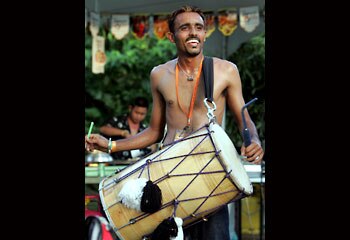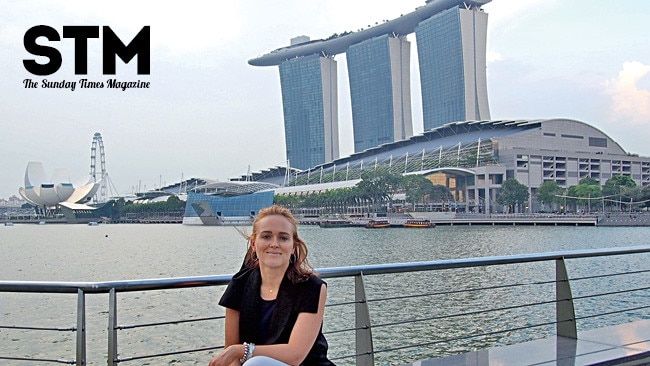Magical Malaysia
EVERY day is a bad hair day for a young orang-utan: the cartoon electrocution look. Add the huge, wide eyes and you get an expression of permanent alarm.

EVERY day is a bad hair day for a young orang-utan: the cartoon electrocution look. Add the huge, wide eyes and you get an expression of permanent alarm.
Baby orang-utans spend most of their lives clinging to the hair on their mothers' backs, grabbing the bits of fruit mum chooses to share with them.
The slightly older ones exercise their independence by moving away – not too far, mind – to another branch. It's practice for the day when they get to be about five and can make their own way in the world.
All things considered, being an orang-utan isn't such a bad life on the Semenggok reserve, in Malaysia's Sarawak.
Not only is there an endless supply of fruit provided by the rangers, but an endless stream of visitors from nearby Kuching, the provincial capital.
The 22 orang-utans of Semenggok have daily opportunities to show off for visitors, and each deals with the stress of public appearances in a different way.
A bit of minor acrobatics, like hanging upside down by the feet, is usually enough to impress the visitors. The adults mostly strike an air of world-weary boredom as they munch their way through a small plantation's worth of fruit.
Then there's Ritchie. Ritchie often doesn't bother to turn up at all. But, when he does, everyone knows about it. As dominant male of the clan, he gets to eat first, while everyone else sits back and waits their turn.
Ritchie, now about 27, got his name from local writer James Ritchie, who brought him to the Semenggok rehabilitation centre a few years ago.
There, he joined other orang-utans that had been rescued from shooters or confiscated from locals who kept them illegally as pets.
(Nobody has satisfactorily explained who would want an orang-utan as a pet. The powerful adults are quite capable of doing an Aunty Jack and "ripping your bloody arms orf".)
Since then, Ritchie has done his best to populate the world with orang-utans – all the Semenggok youngsters are his offspring. Well, perhaps all.
Minder Chong Jiew Han says Ritchie's heir-apparent, George, may well have already enjoyed the odd illicit treetop affair.
There's little love lost there. Last time they tangled, Ritchie broke George's arm. George now keeps his distance.
Semenggok has built its population in just a decade from the first arrivals, which included a baby named Bullet, wounded by the same shot that killed his mother. The 600ha of jungle, just enough for one dominant male and his clan, is devoted to re-acquainting orang-utans with the wild.
Success for the minders will be the day when none of Ritchie's clan turns up at feeding times – that would mean they're getting enough food in the wild.
But if life in the reserve is comfortable, even idyllic, it's a cruel world outside. In the past 20 years, something like 80 per cent of the orang-utan habitat has permanently disappeared, largely because of logging.
There are now only 10,000 to 15,000 here on the huge island of Borneo, in small, scattered groups mostly out of contact with each other. The only other orang-utan population, about 7000, is on the Indonesian island of Sumatra.
It's a slow process building up their numbers. Orang-utans live to about 40, but mothers don't breed during their five years or so of raising each baby. This means the average female can have no more than three youngsters in a lifetime.
All this wilderness living takes place on the suburban outskirts of Kuching, a city of 500,000. It's a surprising place with a unique history.
Named after a jungle cat, the area entered modern history in 1842 when English adventurer James Brooke helped the sultan of Brunei defeat a revolt against the local governor.
In return, the sultan gave Brooke his own little kingdom and the title of "rajah". Brooke repaid this kindness by organising the local tribes of headhunters and pilfering large areas from his former boss.
For a century, the Brooke family ran Sarawak as their own private colony, transforming Kuching into a graceful, brick-and-stone outpost.
That ended with the Japanese occupation in World War II, after which the last of the "white rajahs" ceded his colony to the British. It then became part of independent Malaysia.
There are reminders of the romance of the remote outpost as you stroll on the waterfront, through the clamour of the markets, the murmured business of the shops and stalls of India St Mall, or the steamy cooking chaos of Chinatown.
The former Brooke palace, now the governor's residence, serenely overlooks the city from the other bank of the muddy Sarawak River.
And this town is friendly – everywhere, there are smiles for the visitor and eager conversations, made possible by Malaysia's long-standing practice of compulsory English in schools.
About 45 minutes west is Damai Beach and its resorts, and the Sarawak Cultural Village, set up as a working longhouse village, where the lifestyle and music of the dayaks is preserved. Each July, it's the scene of a world-music festival.
The real thing, with traditional longhouses up to 300m long, still goes on in the jungle interior, where some communities welcome visitors.
The Ibans, the largest group, are so devoted to longhouse living that even city sophisticates return up-country whenever they can.
A day's excursion away, in a beautiful jungle setting, is Bako National Park, home to the proboscis monkey, which has a distinct nose and spends its life in a breeding frenzy.
Back in Kuching, we watched over a couple of cold Tiger beers as the tropical sun set lazily over the white rajahs' old palace, the ferrymen guided their little boats across the river and young couples strolled along the bank. Not everything changes, thankfully.
The writer was guest of Tourism Malaysia and Malaysian Airlines.
The Sunday Telegraph



